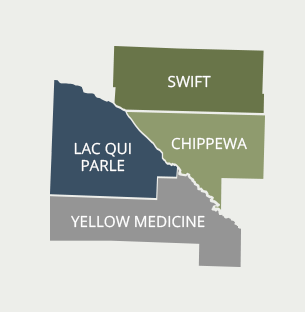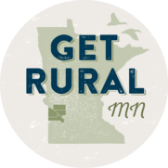Salt Lake Wildlife Management Area
 Located near Marietta, Salt Lake is a haven for migrating shorebirds and waterfowl. This makes for fascinating and unique birdwatching. Some bird species that have been seen in the area include: loggerhead shrike, ruddy turnstone, bobolink, Swainson’s hawk, western grebe, and cinnamon teal.
Located near Marietta, Salt Lake is a haven for migrating shorebirds and waterfowl. This makes for fascinating and unique birdwatching. Some bird species that have been seen in the area include: loggerhead shrike, ruddy turnstone, bobolink, Swainson’s hawk, western grebe, and cinnamon teal.
On an irregular basis, the site harbors breeding populations of eared grebes, Wilson’s phalaropes and American avocets. The Minnesota Ornithologists’ Union takes a field trip to Salt Lake the fourth weekend in April. Typically, birdwatchers see more than 130 species on these outings. Snowy egrets, although rare in Minnesota, have become expected there.
Lac qui Parle means the “lake that speaks”—with the sounds of birds. Lac qui Parle County, in southern Minnesota, is one of the top birding destinations in Minnesota. Two bodies of water, Salt Lake and Lac qui Parle, offer exceptional opportunities in spring to spot hundreds of species of birds.
At Lac qui Parle, part of the broader Lac qui Parle Wildlife Management Area, spring migratory journeys bring golden plovers, snow geese, wood ducks and tundra swans. Bald eagles are sighted in the spring, and some nest here. As many as 10,000 pelicans nest at Lac qui Parle.
About an hour’s drive from Lac qui Parle, the shallow, alkaline waters of Salt Lake attract spring waterfowl and shorebirds such as willets, piping plovers and sandpipers to feast on pondweed and brine shrimp. Salt Lake is one of the few Minnesota habitats where the American avocet nests.
In late April, birders celebrate spring migration at the annual Salt Lake Birding Weekend. Typically, birdwatchers see more than 130 species. Snowy egrets, rare in Minnesota, are regularly sighted here. Other past highlights include sightings of American golden-plovers, American pipits, winnowing Wilson’s snipe, marbled godwits and horned grebes. In the months following migration, birders at Salt Lake might find eared grebes, American white pelicans, tundra swans and other summer birds.
To reach Salt Lake, head to Marietta on Hwy. 40. Go 3 miles south of Marietta on Co. Rd.7. Salt Lake Wildlife Management Area is 1 mile west on the township road. Park on the southeast end of the lake.
Salt Lake Birding Weekend for more info, call the Madison Chamber Office at (320) 598-7301 or Prairie Waters at (866) 866-5432, or click here to visit the Salt Lake Weekend website. See you at Salt Lake!
Madison Area
Marsh Lake, a man-made reservoir on the Minnesota River west of Appleton, has one of the only two nesting colonies of white pelican in Minnesota. Lac qui Parle Wildlife Management Area is a stopover for fall migrating Canada geese. Flocks of up to 100,000 can be seen during peak migration in late October. For more information call the Madison Area Chamber of Commerce at (320) 598-7301.
More birdwatching information can be obtained by calling the U.S. Fish and Wildlife Service, Morris Wetland Management District Office located south and east of Morris on Co. Rd. 10. The office and display area are open to the public Monday – Friday 7:30 a.m. – 4:00 p.m.
Big Stone National Wildlife Refuge
The 10,000 acre Big Stone National Wildlife Refuge features car and bike tour routes and foot trails. Big Stone Refuge boasts over 260 bird species that utilize the Refuge’s grassland and wetland habitats. The Refuge serves as a major migratory stopover for more than 20 species of waterfowl and 30 species of shorebirds. The highest concentrations of some shorebird species in the state of Minnesota and in the prairie potholes can be found on the Refuge. Bald Eagles have successfully raised 2-3 eaglets every year on the Refuge since 1995. Located just south of Ortonville on Highways 7 & 75, the refuge offers a hard-surfaced 9.3 mile auto tour route. Hiking trails begin at the edge of the parking lot complete with public restrooms. A public canoe access is also available and wildlife observation opportunities abound.
State Parks
The State Parks in our region are Lac qui Parle, Monson Lake, and Upper Sioux Agency. You can also contact the Lac qui Parle Wildlife Refuge office at (320) 734-4451.
More Information on Birding
For more information on Birding in the Prairie Waters Region, check out these helpful links:








